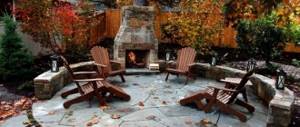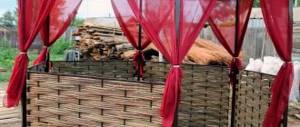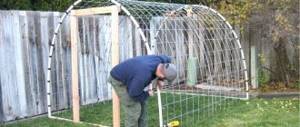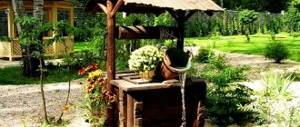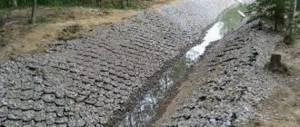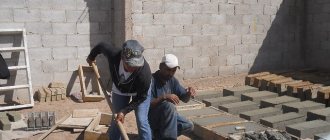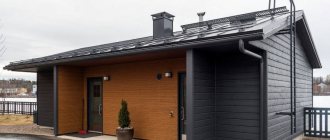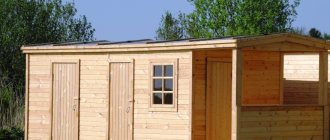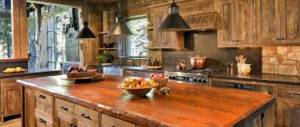A winter garden in a private house, apartment, country house or balcony is a piece of summer all year round. Creating a cozy place of beauty and relaxation involves the implementation of a serious engineering solution and requires scrupulousness at all stages, from the creation of the project to its implementation. If you take into account all the nuances, a home greenhouse will become the highlight of home ownership, and caring for it will become a favorite hobby. This article will help you correctly design, create and arrange an indoor garden.
A winter garden is a special corner in a house or apartment where various indoor plants are placed, creating a special atmosphere
What is a winter garden: main characteristics and features
A winter garden is a room with a specific purpose. Serves for placing exotic, indoor and heat-loving plants, requires special heating, water supply and lighting systems with the most rational use of natural solar heat and light. Usually this is a glass structure in a metal, aluminum, wooden or metal-plastic frame. It can be a continuation of the living room in the form of a terrace.
Plants in the winter garden are able to purify the air space from harmful substances, saturate it with oxygen and a unique floral aroma
A winter garden is not a separate building, but an integral part of the house. It is protected from atmospheric influences (rain and wind) by a glass roof and walls.
The beauty and aroma of flowers have a positive effect on the human nervous system. The green zone performs a number of positive functions, in particular:
- enriches the room with oxygen;
The winter garden can be organized as an extension to the house in a separate well-lit room
- prevents dust from entering the living space;
- caring for plants becomes a useful and original hobby;
- the green zone is an area of comfort and relaxation at any time of the year and in any weather.
Helpful advice! To build a winter garden, it is not necessary to have a spacious house or yard. You can even create a cozy summer corner on the balcony or loggia of your apartment.
A winter garden is a glassed-in room with heating and natural lighting, which can be either a separate building or a continuation of a residential building.
Frame and roof
In appearance, a winter garden may look fragile due to its transparency and even some airiness. However, it’s good if she only seems like one. To withstand winds, snowfalls and the scorching sun, the structure must be strong and reliable. For this, it is also important to choose a good frame material. There are many options, let's look at their brief descriptions.
Table 2. Types of frame materials.
| Material name | Characteristic |
| The most popular version of the frame has many advantages: - lightweight; - durable; - durable; - not subject to rust. The main disadvantage of an aluminum profile is its high throughput (it does not retain heat), which means you will have to take care of thermal protection. | |
| Wood is often combined with brick, but timber is not a very popular material because: - it can rot; - changes shape and size with temperature fluctuations; - afraid of moisture; - expensive and complicated. If you choose durable and high-quality wood, the building will be durable, but its cost will increase significantly. | |
| An undeniable advantage of a steel frame is its high strength and durability. But the disadvantages are also significant: - very heavy weight; - high price; - susceptible to corrosion. | |
| Good material, characterized by such advantages as: - resistance to UV rays; — excellent thermal insulation; — high noise insulation. | |
| Brick is used quite often to create a frame base. Pros: - strength; — moisture resistance; — ease of installation; - durability. However, the material is heavy and quite expensive. |
Further, everything will depend on the selected materials and the type of future construction. For fastening, you can use a welding machine (if the frame is made of steel), a screwdriver, a drill, etc. Parts can be fastened with nails, dowels, and self-tapping screws.
After the frame is made, the sheathing begins. The material from which the structure will be sheathed will determine the pitch between the frame guides.
Please note: do not forget about the joints between the walls of the home and the home “oasis” - they need to be treated with insulating foam.
If we talk about the roof of the future winter garden, it is also important to choose the right material. Of all the above, glass is the least suitable: it may not withstand the weight of snow that falls in winter. The best option is polycarbonate or double-glazed windows (2 or 3 chamber).
Attention: do not choose double-glazed windows with a glass thickness of more than 5 mm, since such material is too heavy for the roof.
A pitched roof will be an excellent solution to prevent precipitation from accumulating on the roof surface and preventing the penetration of light.
Video - Winter garden assembly process
Winter garden in a private house: history
Back in the 4th millennium BC, the first winter garden appeared. Pictures of stone vases in the palaces of Ancient Egypt clearly demonstrate this. The followers of the Egyptians are the ancient Romans, who began placing mini-gardens on window sills. Rich owners of estates could afford a peristyle - a garden in the middle of the building, surrounded by columns.
Winter gardens reached Europe already in the 11th century. King William of Holland built a flower greenhouse in his palace. Soon, “orange houses” appeared - these are buildings where citrus fruits bloomed all year round.
At all times, winter gardens have been widely used in the construction of country houses, penthouses, cultural and recreational and business centers
The orangery in Versailles from the time of Louis XIV is considered the most beautiful in history and has survived to this day. No less famous are the greenhouses of the Potsdam Sanssouci Palace. In the 18th century, citrus fruits replaced tropical plants. Winter gardens were considered a luxury until the 19th century, when Nathaniel Ward tried growing plants under a glass dome.
In 1854, Englishman Joseph Paxton built the Crystal Palace, the prototype of a modern winter garden.
If initially winter gardens were used exclusively for growing heat-loving exotic plants, now they can be a place for a living room, office, gallery or just relaxation
Today, almost anyone can add a winter garden to their home. It can also be placed on a balcony or terrace.
Winter garden and greenhouse in the house: similarities and differences
There are certain differences between a greenhouse, greenhouse and winter garden, despite the fact that these concepts are related. All rooms have the same purpose in terms of cultivating plants in the intermediate zone between housing and open area. At the same time, the greenhouse and conservatory are independent buildings, and the winter garden is an integral part, a harmonious continuation of the living space.
A greenhouse (a more simplified version - greenhouses) is mainly focused on growing plants in special conditions
Greenhouses, for the most part, have a temporary purpose for growing different types of crops in special conditions at a certain stage. From the photo of the greenhouse it is clear that this is a place for growing exotic varieties of plants, for example, orchids or citrus fruits. For this purpose, special climatic conditions are created with high humidity and temperature, which can be difficult for the physical condition of the human body. A long stay in them is uncomfortable and undesirable.
The winter garden can be called an intermediate zone between the living space and the natural environment
The main purpose of a winter garden at home is to give pleasure from contemplating the lush greenery of small trees, the beauty of bright flowers and their fragrance. The microclimate of the garden under glass is selected rationally, having a positive effect on both cultivated plants and the well-being of people. Such harmony can only be created subject to strict adherence to all construction and landscaping rules.
Note! A winter garden should not be confused with a greenhouse, which is located outside the house and is used for growing seedlings of garden crops and flowers. A flower greenhouse differs from a garden in its tropical microclimate with high humidity and air temperature.
Like a greenhouse, a winter garden is designed to protect plants and flowers from freezing in autumn and winter.
Winter garden in a private house: photos, varieties and features
A winter garden is a rather complex engineering and technical structure. The main feature of the future building is to keep the plants comfortable, protected from frost and other negative environmental influences. Therefore, during design the following conditions must be met:
- maintaining a constant temperature regime;
A winter garden is a serious engineering solution that requires compliance with the nuances of pre-project preparation, design and construction
- constant air circulation;
- sufficient lighting;
- optimal air humidity;
- sealed frame.
The design of the winter garden, regardless of where it is located, must be transparent, sufficiently illuminated, aesthetically designed, and resistant to the influence of external factors.
The winter garden conventionally has several internal zones:
- communicative - performs a function connecting with the house. These are paths that lead to the house on one side and to the street on the other;
A winter garden always gives a house its own unique look and style, adding a special touch
- recreational - part of the interior where pieces of furniture for relaxation, meetings, and meals are located;
- decorative - the main zone where the plants are actually located;
- service – the place where equipment, fertilizers, and access to communications are located.
There are many designs for houses with a winter garden, which involve their construction together with the main room, but glass extensions for growing plants are more popular.
Layout of a winter garden attached to the house
Before attaching a winter garden to the house, it is necessary to decide not only on the size and landscaping, but also on its location so that all of the above conditions are met.
The most optimal side for placing a winter garden is eastern. The structure in this area will not overheat. Plants will receive the necessary solar energy from the cool morning sun.
Rectangular translucent structure in the form of a winter garden extension to a house with a pitched roof
The western side is also quite acceptable and successful, the second most optimal. But such a placement project will succumb to excess heat, especially in summer, and will therefore require additional watering.
The south side is often considered the most suitable for placing a winter garden. This opinion is very misleading. The south of the house is an unsuitable area for installing a winter garden. Direct sunlight, especially in summer, causes plants to overheat. To avoid this, you will have to provide additional ventilation and watering. It should be noted that in winter it is in the southern garden that heat is retained well and for a long time.
North. The garden in this direction is located only as an exception when there is no other alternative. Heat accumulation in this zone is the least, so you should take care of an additional heating system. Sunlight will also be minimal. Therefore, shade-loving plants are planted in such a garden.
Helpful advice! It is possible to place a small winter garden on a loggia, even if it is on the north side. Phytolamps will help provide a sufficient amount of sunlight. Their service life is about two years, they are expensive, but consume little electricity. At the same time, they perfectly help plants in the process of photosynthesis.
Regardless of the location of the garden, the structural system must be translucent, illuminated, ethereal, beautiful, and also resistant to weather conditions
Winter garden attached to the house: photos, views, location
Depending on the function performed and its location, the winter garden has several types.
A buffer garden is a winter garden attached to the house in the form of a glazed terrace or veranda. Mini-option – vestibule or balcony.
A winter garden in a private house is a specially designated room or part of the room, fully or partially glazed. This could be the living room or dining room.
An attached winter garden is an additional way to expand the usable area of the house
A house greenhouse is a non-residential extension with an artificial microclimate where exotic plants are cultivated.
Rectangular winter garden extension to the house. This design is a universal and most popular option. The building has a transparent pitched roof.
Angular. A green area can be created using an extension to the outer corner of the house.
Two-facade extension. This option involves an extension to the inner corner of the house. Another name for an extension is a quarter-polygon with a combined four-beam or gable roof.
The three-facade design is the most efficient in terms of lighting. Three walls of the extension are glass, and the fourth is one of the walls of the main building.
The winter garden can be a structure adjacent to the house or a separate building connected by a corridor or glass passage to the main room. Each option affects the design and arrangement of heating, water supply and ventilation systems. To get a complete picture, you need to study in detail examples of different designs of houses with a winter garden. Photos clearly illustrate this diversity.
Option for an original greenhouse on the roof of a house
Helpful advice! The ideal location for a winter garden in a country house can be a veranda. Its creation is quite simple and does not require large expenses. You just need to install ventilation and heating. Another simplified option is a winter garden on the roof, which makes it possible to save on the foundation, but the frame and roof will still have to be built. You also need to think about how to build the stairs.
The three-facade design of the winter garden is adjacent to the building on only one side
Choosing a place
If you are planning to place the structure of the future winter garden in a house extension, it will be very important to decide on which side it is best to do this: southern, northern, eastern or western. Each option has certain pros and cons.
- North . The location is not the best, since the garden will quickly release the accumulated heat to the outside. If there is no option to choose the other side, you need to take care of a good heating system.
- South . The good side is during the cold season, when daylight hours are short and there is little sun. On warm summer days, the plants will be too hot and stuffy there, the owner will have to water them more often, provide shading and access to fresh air.
- East . This is the most successful location option: in the first half of the day the plants will be provided with light and warmth, and in the remaining time the flowers will “rest” from the sun. Thus, overheating of crops will be excluded.
- West . The solution is also suitable: the heat accumulated during the day is retained throughout the night. This is good for winter, but in summer you will have to provide additional ventilation and good watering.
Features of creating a winter garden project
There are more than a dozen projects for a winter garden attached to a house. Photos demonstrate their diversity:
- Rectangular lean-to extension.
- Rectangular lean-to extension with a break
- Rectangular gable extension.
- A lean-to winter garden attached to the inner corner of the house.
- A lean-to winter garden attached to the outer corner of the house.
- Single pitch bay window extension to external corner.
- Corner single-pitch, single-bay window building.
- Single-pitch double bay window design.
- Single pitch, single bay corner extension.
- Gable winter garden with bay window.
Scheme for constructing a winter garden in a private house
The roof of a lean-to extension has one roof slope with a minimum slope of 10°. Builders recommend maintaining an angle of at least 25°, and the most optimal is 45°. A gable roof, as a rule, has two slopes, block extensions have three or more roof slopes.
Winter garden projects in the form of gazebos are quite common; their classification depends on the number of edges and the method of extension:
- multifaceted;
The roof of the winter garden is an important architectural detail that transforms the space of the room
- hexagonal;
- triangular.
Design of a winter garden in a private house
The aesthetic function of a winter garden implies compliance with style. There are several most common options for the design of a winter garden.
Classic style. It implies the location of the greenhouse in a spacious room, with many plants that grow in the same climatic zone. Clear symmetry and strict design are the hallmarks of classics. An element of decoration for such a garden can be parrots or canaries in cages or a pond with fish. Stumps, driftwood, stones, and small trees serve as decoration.
The main difference between classic winter gardens is the high multi-cascade glazed roof
Japanese style. The presence of free space, good ventilation, conciseness and asymmetry are the main distinguishing features of the Japanese winter garden. At the same time, the apparent external simplicity requires a professional approach to its creation.
Hi-tech. Exotic plants, clear geometry. Concrete, metal and combined materials are used in the design. This garden is a great addition to the office.
Modern. The style was popular at the turn of the millennium. Distinctive features are clarity of lines, presence of air space and a minimum of decor.
In a high-tech winter garden, the main task is to use the available space in the most functional and practical way
Before making a winter garden in a private house, you need to design it - this is a labor-intensive and most important stage of creation, which includes:
- Sketch stage. When creating a sketch, special design programs are used. The most popular of them are Solid Works, Auto Cad, Pro Ingeneer, 3Ds Max. The sketch shows the number of windows, transoms and hatches.
- Creating a project is a clear drawing of the diagrams for connecting the winter garden to the wall of the house, the dimensions of the structures and the proposed material. Lighting, shading, water supply and heating systems are planned. It is necessary to calculate the power of the racks and crossbars.
- At the design stage, drawings are directly drawn up, according to which you can build a winter garden in a private house with your own hands.
Helpful advice! It is quite possible to build a winter garden with your own hands, having a detailed and detailed project, but it is better to entrust the creation of the project to experienced architects.
Choosing lighting
The walls and roof of the winter garden are sheathed with transparent material, which means there should be no problems with lighting. Still, plants often need additional light. There are a large number of sources of artificial lighting: mercury, sodium, fluorescent, LED, metal halide, phyto-lamps and incandescent lamps. Of these, fluorescent ones are the most popular because they save energy, provide excellent illumination and have low heat dissipation.
Phyto-lamps are especially good: they have a positive effect on photosynthesis. The downside of this option is its price.
Don’t forget that too much light is also bad.
Step-by-step instructions for making a winter garden
How to make a winter garden - the best advice will be given by experts, since a professional approach requires not only design, but also installation. By following the advice and clearly following the instructions, you can get the desired result.
You can choose a rational project and build a winter garden with your own hands, but in any case this will require certain money and time costs from the owners of apartments and houses
Depending on the location of the winter garden to the main room, calculations are made and materials are selected. The structure that is adjacent has no more than three common parts with the house. The created extension should not reduce the thermal insulation characteristics of the main room, but, on the contrary, help reduce heat loss. It depends on engineering calculations and materials.
The construction of a winter garden, in addition to the construction of the foundation and the direct installation of the supporting structure, includes the following stages:
- glazing and insulation of the extension;
To be able to spend time in the winter garden all year round, you need to choose glass of the highest quality with thermal insulation
- installation of a heating system;
- installation of water supply and irrigation systems;
- electrical wiring and lighting;
- ventilation system equipment;
- installation of protection from excessive exposure to sunlight;
- selection of plants and garden decoration.
Construction of the foundation and installation of the frame
The foundation of a winter garden is the basis on which the strength and durability of the entire structure depends. The cost part can be a fifth of the entire construction budget.
For such buildings, shallow strip foundations are used. Ready-made reinforced or reinforced concrete slabs with a thickness of more than 20 cm are suitable. The choice of depth is influenced by the composition of the soil, climate, and topography.
During the construction of the winter garden, it is recommended to make a strip foundation, laying it to a depth of 80-100 cm, with a base height of 6-10 cm
The building frame can be purchased ready-made. Fortunately, the modern market offers many models. Installation does not take much time and effort, but you cannot do it alone - support is required. Structural parts are attached to special connections in the foundation.
Glazing of the winter garden in the house
Glass is one of the main materials used in the construction of a winter garden. When designing, it should be taken into account that this material is quite weighty and can create a certain load on the supporting structure; it is also increased by the effects of wind and snow.
The key point in creating a winter garden is glazing - the glass must certainly be thermally insulated
The estimated loads at the joints are calculated using the same method as for metal-plastic glass structures, where the post-transom serves as the connecting link of the load-bearing structures. Thermal characteristics correspond to the glazing of a living space. To prepare the calculations, SNiP 2.01.07-85 is used, taking into account changes dated May 29, 2003.
The construction of a winter garden implies the presence of openwork load-bearing structures. This can be a problem, especially in temperate regions where temperatures vary by 50°C or more throughout the year. Therefore, vertical supports must create a heat transfer resistance (Rwr, m2K/W) from 0.4 (SP 23-101-2004).
Project of a winter garden attached to the house
Such parameters have designs made of single-chamber double-glazed windows, but require the installation of a load-bearing brick support with a side of at least 230 cm, which can negatively affect the illumination. Combining wood and aluminum will help solve the problem.
Additional thermal insulation must be created at the connection line between the glass wall and the pitched roof.
Note! The roof requires special attention when glazing. Single-pitch with one purlin is the most economical. When choosing glass, you need to take into account the snow load in the region. The slope angle is at least 20 degrees. It should be noted that slopes with transitions will create problems when the snow melts.
Heating the winter garden
Glass or polycarbonate can accumulate sufficient heat for more than six months - from mid-spring to mid-autumn. In cold weather, you need to worry about efficient heating.
When choosing a heating method, it is necessary to take into account the size of the room and the type of plants being grown. If this is a small greenhouse on the balcony, then a simple heater is enough; if the winter garden is in a private house, then you cannot do without a heating system.
Thanks to heaters, a stable temperature is established in the winter garden room, suitable for growing certain plants
You can heat a greenhouse in one of several ways.
Electric heaters. Convenient in terms of their mobility, ease of installation and use if necessary. At the same time, operation leads to significant financial costs. Frequent use dries out the air, which has a negative effect on plants.
Air conditioners and heaters UFO. With their help, you can regulate the temperature without drying out the air, but they are expensive to purchase and operate.
Water heating is often used to heat winter gardens and terraces in private homes. Such a system involves connection to the main heating system, which allows you to maintain a constant temperature, without differences between the living rooms and the garden. This terrace serves as an excellent place to relax. The placement of heating pipes along the walls protects the walls and roof from icing.
By placing a “warm floor system” under the top covering, you can significantly simplify control over maintaining a stable air temperature in the winter garden
Stove heating is an opportunity to use alternative raw materials. The design of the stove will add a special flavor to the garden. At the same time, uneven heat distribution may occur; the oven requires close attention due to its high fire hazard.
Air heating is the distillation of warm air from the main heated room or using an air heater. The system is low-cost, but requires additional insulation; the air ducts are quite voluminous and can spoil the appearance.
One of the most common ways to heat an attached winter garden in a house is a stove.
Warm floors in the garden are labor-intensive to design, install and connect. Installation must be carried out before arranging the garden. The system allows you to create an optimal thermal regime in the garden and promotes the development of roots.
Helpful advice! Combining several types of heating will create an optimal heating system. It should also be taken into account that heating is closely related to the ventilation system.
Even at the stage of selecting materials, different coefficients of thermal elongation should be taken into account. Thus, taking into account temperature differences of up to 50°C, the thermal expansion of aluminum per meter of length is 1.2 mm, steel – 0.65, glass – 0.45. These data must be taken into account to avoid deformation. The air temperature during installation should also be taken into account. Gaskets and sealants serve as sealing.
Using an IR heater for a winter garden, it is possible to maintain stable humidity, since the air does not dry out or burn out during heating
Installation of water supply and irrigation system in the winter garden
There are many different irrigation systems that allow irrigation to be carried out automatically, using different watering modes according to the need for moisture.
The most popular is an automatic drip irrigation system. It is a perforated hose through which irrigation is dosed. Water gets exclusively to the roots of plants, and special sensors allow you to control the moisture level in the soil.
For water-loving plants that require irrigation of the vegetative part, special fountains are installed. The devices simultaneously humidify the air and serve as decoration for the garden. Excess water must be drained through an equipped drainage system.
A winter garden equipped with a pond does not require additional methods of humidification
A winter garden with a swimming pool does not require additional moisture. A pond with internal circulation and a connected drainage system will provide the necessary water circulation in the greenhouse.
Electrical wiring and lighting: savings and efficiency
Plants in the cold season and cloudy weather experience a lack of sunlight, which negatively affects their growth and requires the installation of additional lighting in the winter garden.
To do this, you should not use ordinary incandescent lamps. They do not promote photosynthesis, but on the contrary can harm tall plants with excessive heat.
Additional lighting in the winter garden can be organized using fluorescent, sodium or metal halide phytolamps, which are selected in accordance with the characteristics of the plants
Fluorescent and metal halide lamps are also not suitable due to their relatively short lifespan. Sodium lamps that are sensitive to voltage changes should also be excluded from the list.
But phytolamps were specially invented as an additional source of light for plants. They are divided into LED and fluorescent.
The functioning of most life-supporting systems in the garden depends on the power supply, so even when designing, you need to think about the type of electrical wiring, where to connect sockets and lamps.
Good natural light for plants in the winter garden is the main factor ensuring their vital activity
Helpful advice! To illuminate an area of 5 m², you will need 4 metal halide lamps with a power of 40 W or just one sodium lamp with a power of 250 W.
Ventilation system equipment
A winter greenhouse or garden, no matter where it is located - in an extension, a separate building or an apartment balcony - requires ventilation. Ventilation can be accomplished in one of two ways.
Natural ventilation is carried out by opening the vents or windows. In this case, the area of the open spaces should be at least a quarter of the area of the walls. Supply and exhaust ventilation is also considered natural. Fresh air enters through special openings in the walls and through vents in the roof. This system does not cause noise or drafts. It should be remembered that window doors can be damaged by the wind.
Ventilation of the winter garden is carried out by a wall fan
Mechanical ventilation involves the use of fans to remove air. At the same time, it does so naturally. Such a system requires an electrical connection and creates noise.
Protecting the winter garden from strong solar radiation
Plants can suffer from either too little or too much sunlight and heat, especially in the hot summer. For this purpose, means of protection from sunlight have been invented. Curtains and blinds that can block 40% of light provide internal protection. They are made from fabric, plastic, bamboo or metal alloys.
External protection in the form of awnings and awnings prevents the penetration of up to 90% of light. They are made from reflective fabric. This protection also prevents excessive heating of the walls.
Blinds in the winter garden are the main internal shading systems; they protect the room from bright sun and heat
Plants for the winter garden and decoration
Along with heating, lighting and watering, you need to take care of high-quality soil, ensure it is sufficiently fertilized and enriched with oxygen. It is best to use special soil-woody mixtures. When choosing plants for a winter garden in a private home, you need to be guided not only by taste, but also by the ability of different species and varieties to coexist.
Regardless of the size, design and location of the greenhouse, the combination of colors for a winter garden in a private home should be a well-composed composition, and not represent bad taste in the form of a collection of pots. It is simply unrealistic to collect plants from different parts of the planet in one place, because representatives of different species and climatic zones require special conditions.
A greenhouse at home requires the constant presence of flowering plants, so experienced gardeners plant plants depending on the time of year.
In winter, preference is given to primrose, Kalanchoe, daffodils and tulips. With the advent of spring warmth, additional hyacinths, lilies, hydrangeas, pelargoniums, astilbes, and schisanthus are planted. In summer, one bulbous plant is replaced by another. Oriental and Asiatic lilies, begonias, zinnias, perillas, vincha, salfia, and echinacea grow well. Autumn is the time of cyclamens, kochias, gomphenas, and chrysanthemums. With this approach, the winter garden will be fragrant with exotic flowers all year round.
When choosing plants for the winter garden, it is important to make sure that they are somewhat diverse; this will add charm and originality to any room.
Helpful advice! It is very difficult to create several microzones in a winter garden, so it is better to choose plants belonging to the same category. For example, for the growth of tropical plants the optimal temperature is 22°C, for subtropical plants – 10°C.
Selecting materials
The inside of the winter garden should be comfortable not only for people, but also for plants. This determines the specific choice of materials for walls and roofs: these structural elements should provide your crops with maximum access to light. Based on this, glass, polycarbonate, double-glazed windows, and sometimes plexiglass are most often used when finishing walls and roof coverings. Let's look at the advantages and disadvantages of each material.
Glass
This type of cladding is the most used. Glass is so popular due to a number of significant advantages:
- high load-bearing capacity;
- aesthetics;
- light transmittance (98%);
- fast heat transfer.
These positive properties do not exclude some disadvantages. Glass is a fragile, quite expensive and difficult to work material.
Polycarbonate
The most modern and technological solution, which is popular in the field of construction and finishing. It has many advantages:
- budget;
- easy to process;
- plastic (can be bent);
- moisture resistant;
- resistant to moisture, fungus, corrosion;
- easy.
Please note: polycarbonate has a top layer of protection that does not allow moisture to pass through. This makes it virtually invulnerable to precipitation.
Polycarbonate would be an ideal material if not for some disadvantages:
- low thermal efficiency (good heating will be needed);
- transmits less light than glass (88%).
Double-glazed windows
Today, when creating winter gardens, double-glazed windows have become more often used, despite their high cost and heavy weight. This popularity is due to their high light transmittance (like glass) and excellent heat retention. Also, if your budget allows, you can opt for energy-saving double-glazed windows: they will help significantly save heat.
Plexiglas
As a rule, it is not used as an independent one. Suitable for side walls in combination with other materials. It has a significant disadvantage - it is heavy, which makes you think about a more durable frame.
Winter garden in an apartment: rational location and design
You can create a piece of summer not only in a house with a yard, but also in an apartment. To do this, it is enough to have the desire to rationally distribute the space, filling the space with flowers. Climbing plants on the walls will create a vertical garden. Pots can be placed at the bottom and allow the stems to stretch upward along special supports. If, on the contrary, the flowerpots are hung, the plants will simply fall down freely.
It is better to place light-loving flowers in the apartment closer to the windows, creating a background. The second row from the window is the optimal place for lush flowering plants. It is better to place large-leaved flowers in the third row, and leave the central part to large and attractive representatives of the fauna.
Winter garden on a balcony or loggia
A spacious balcony or loggia is the best option for placing a winter garden in an apartment. Here you can place a different number of ornamental plants, having previously prepared the area. It is also worth taking care of insulation, heating and additional lighting.
Thanks to the plants of the winter garden, the balcony “enriched” with oxygen can be used as a bedroom, dining room or study
A loggia is a great place to create a greenhouse in an apartment. The main thing is a positive temperature and a sufficient amount of light, which can ensure the placement of the garden in the east or west. The southern side will allow you to grow heat-loving cacti and phlox, and the northern side will allow you to grow coniferous crops.
Helpful advice! You can create a greenhouse in your home with your own hands in any free corner or throughout the entire apartment, using additional functional features of plants. For example, climbing ivy or a sprawling fern will become a “living” drapery in an unsightly corner.
The winter garden is an excellent place for rest and relaxation. The process of creating it in a private home is labor-intensive and requires attention and some effort. If you take into account all the engineering features, have the funds and time, then it is quite possible to create a private greenhouse on your own. In this matter, you should not neglect the advice of specialists. You can create a small garden in your apartment using your imagination and rational use of space for plants, which will delight you with flowers and greenery all year round, reminiscent of summer.
